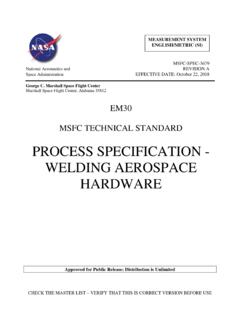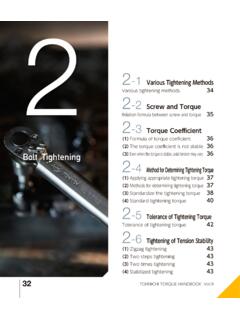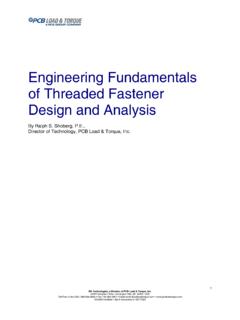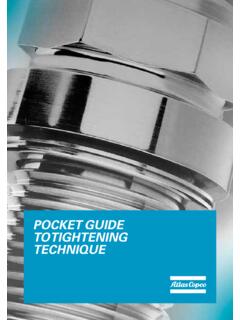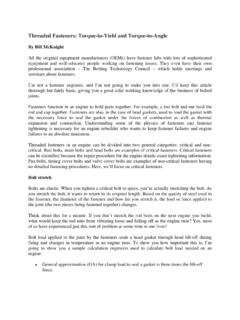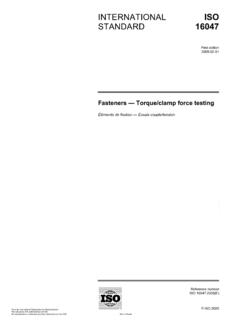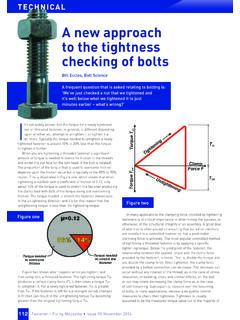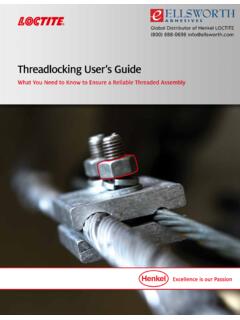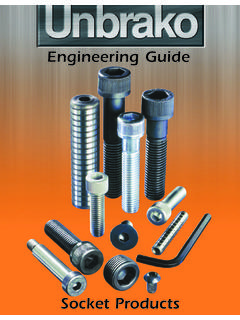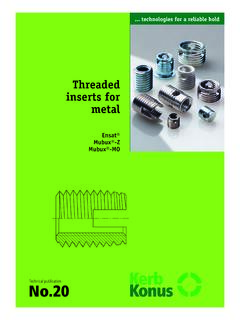Transcription of REQUIREMENTS FOR THREADED FASTENING SYSTEMS IN …
1 NASA TECHNICAL STANDARD NASA-STD-5020. National Aeronautics and Space Administration Approved: 03-12-2012. Washington, DC 20546-0001. REQUIREMENTS FOR THREADED FASTENING . SYSTEMS IN SPACEFLIGHT HARDWARE. MEASUREMENT SYSTEM IDENTIFICATION: METRIC/SI (ENGLISH). APPROVED FOR PUBLIC RELEASE DISTRIBUTION IS UNLIMITED. NASA-STD-5020. DOCUMENT HISTORY LOG. Status Document Approval Date Description Revision Baseline 03-12-2012 Initial Release APPROVED FOR PUBLIC RELEASE DISTRIBUTION IS UNLIMITED. 2 of 88. NASA-STD-5020. FOREWORD. This Standard is published by the National Aeronautics and Space Administration (NASA) to provide uniform engineering and technical REQUIREMENTS for processes, procedures, practices, and methods that have been endorsed as standard for NASA programs and projects, including REQUIREMENTS for selection, application, and design criteria of an item.
2 This Standard is approved for use by NASA Headquarters and NASA Centers, including Component Facilities and Technical and Service Support Centers. This Standard establishes criteria for ensuring the integrity of THREADED FASTENING SYSTEMS in launch and space vehicles and their associated equipment. Requests for information, corrections, or additions to this Standard should be submitted via Feedback in the NASA Standards and Technical Assistance Resource Tool at Original Signed By: 03-12-2012. _____ _____. Michael G. Ryschkewitsch Approval Date NASA Chief Engineer APPROVED FOR PUBLIC RELEASE DISTRIBUTION IS UNLIMITED.
3 3 of 88. NASA-STD-5020. TABLE OF CONTENTS. SECTION PAGE. DOCUMENT HISTORY LOG .. 2. FOREWORD .. 3. TABLE OF CONTENTS .. 4. LIST OF FIGURES .. 8. LIST OF TABLES .. 9. 1. 10. Purpose .. 10. Applicability .. 10. Tailoring .. 10. 2. APPLICABLE DOCUMENTS .. 10. General .. 10. Government Documents .. 11. Non-Government Documents .. 11. Order of Precedence .. 11. Document 11. 3. ACRONYMS AND DEFINITIONS .. 12. Acronyms and Abbreviations .. 12. Definitions .. 12. Definitions of Variables .. 12. Definition of Terms .. 15. 4. GENERAL REQUIREMENTS .. 19. Strength.
4 19. Ultimate Design Loads .. 19. Yield Design Loads .. 19. Fracture Control and Fatigue Life .. 20. Joint Separation .. 21. Locking Features .. 21. FASTENING System Control Plan .. 22. 5. DESIGN REQUIREMENTS AND CONSIDERATIONS .. 22. Materials .. 22. Specification of Lubricants, Coatings, and Sealants .. 22. Thread Form 23. Use of Washers and Chamfered Bolt Holes .. 23. Locking Features .. 23. Thread Engagement, Dimensions, and Tolerances .. 24. APPROVED FOR PUBLIC RELEASE DISTRIBUTION IS UNLIMITED. 4 of 88. NASA-STD-5020. TABLE OF CONTENTS (Continued).
5 SECTION PAGE. fastener Length Selection for Thread Engagement .. 24. Bolt Grip Selection to Prevent Interference .. 25. fastener Installation Specification and Control .. 25. Installation Torque Specification and Control .. 26. 6. CRITERIA FOR ANALYSIS OF THREADED FASTENING . SYSTEMS .. 26. Nominal, Maximum, and Minimum Preload .. 27. Strength Under Ultimate Design Loads .. 31. Ultimate-Strength Analysis for Tensile Loading .. 31. Ultimate-Strength Analysis for Shear Loading .. 33. Ultimate-Strength Analysis for Interaction of Tension, Shear, and Bending.
6 34. Strength Under Yield Design Loads .. 35. Friction as a Load Path for Shear Loading: Joint-Slip Analysis .. 36. Joint Separation Analysis .. 38. 7. QUALITY ASSURANCE .. 38. As-Built Documentation .. 38. Training .. 39. Installation Tools and Instruments .. 39. Calibration of Installation Tools and Instruments .. 39. THREADED FASTENING System Hardware Inspection .. 39. Locking Feature Verification .. 39. FASTENING System Hardware Procurement, Inspection, and Storage .. 40. APPROVED FOR PUBLIC RELEASE DISTRIBUTION IS UNLIMITED. 5 of 88. NASA-STD-5020. APPENDICES.
7 A. EXPLANATION AND JUSTIFICATION OF fastener . ANALYSIS CRITERIA .. 41. Purpose of Appendix A .. 41. Accounting for Preload Variation when Installing Fasteners with Torque Control (Supplement to Section ).. 41. Rationale for Eqs. ( ) and ( ) .. 46. Short-Term Relaxation of Preload (Supplement to Section ) .. 47. Use of a Load-Introduction Factor (Supplement to Section ) .. 47. Bolt Analysis: Separation Before Rupture (Supplement to Section ) .. 48. Ultimate Margin of Safety for Tensile Loading with Linear Theory (Supplement to Section ) .. 53. Omission of Preload in Shear and Interaction Analyses (Supplement to Section ).
8 55. Theoretical Treatment of Interaction Equations (Supplement to Section ) .. 56. Determining if fastener Yielding is Detrimental for Separation or Joint Slip (Supplement to Section ) .. 61. Margin of Safety for Joint Slip (Supplement to Section ).. 64. Margin of Safety for Bolted Joint Separation (Supplement to Section 66. ) .. Use of a Fitting 66. B. BEST PRACTICES FOR LOCKING FEATURES .. 68. Purpose of Appendix B .. 68. Background and 68. Best Practices for Mechanical Locking Features .. 70. Best Practices for Prevailing Torque Locking Features .. 70.
9 General .. 70. Prevailing Torque Locking 71. Inspect .. 74. Installation and 74. Best Practices for Adhesive Locking 75. Adhesives .. 75. Process Validation .. 76. 78. Inspect .. Clean .. 78. Prime (for anaerobic adhesives only) ..78. Installation .. 79. Verification .. 79. 79. General .. Best Practices for Free Spinning .. 80. APPROVED FOR PUBLIC RELEASE DISTRIBUTION IS UNLIMITED. 6 of 88. NASA-STD-5020. APPENDICES (Continued). C. JUSTIFICATION FOR THE LOW-RISK FATIGUE. CLASSIFICATION .. 81. Purpose of Appendix C .. 81. Conclusions .. 84. D. REFERENCES.
10 85. Purpose of Appendix D .. 85. Reference Documents .. 85. APPROVED FOR PUBLIC RELEASE DISTRIBUTION IS UNLIMITED. 7 of 88. NASA-STD-5020. FIGURE LIST OF FIGURES PAGE. 1 Logic Flow for Minimum Separation Factor of Safety .. 21. 2 Dimensional Considerations in Selecting FASTENING 25. 3 Ultimate Strength Analysis of Fasteners Under Shear Loading .. 33. 4 Dimensions Used to Calculate Load-Introduction Factor .. 48. 5 Determining Whether a Joint Separates Before Rupture When Loaded Solely in Tension ..48. 6 How to Quantify Ductility of a FASTENING System from a Tension Test.
